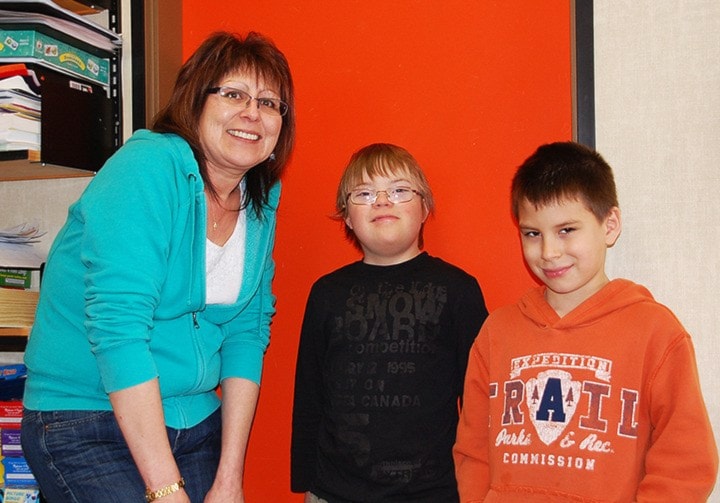"You can change your life," said Sharron Redford, aboriginal support worker for the students at Silverthorne Elementary School.
Officially titled the Aboriginal Support Services Education Team (ASSET) worker, Redford says she strives to lead by example and show the kids that they can work hard and rise above circumstances to be successful.
Redford says that is her main focus, to help kids be successful in school, and she works at it in three ways: (1) academic support (2) social and emotional support and (3) teaching and bringing aboriginal culture into the school.
Using the B.C. government Aboriginal Education Funding, School District 54 made two positions, an ASSET worker to give support to students and a cultural resource teacher, who would separate aboriginal students for part of the day and teach them about aboriginal culture, said Redford.
But the school district decided that they shouldn't segregate them, instead all students should learn about the culture, so they removed the cultural teacher and kept the support worker, who would give support and work to include aboriginal culture within the regular curriculum.
Giving academic support, Redford says she spends quite a bit of time in classes with students, encouraging them and helping them when they need it.
She also runs a homework club at lunchtime for any students who need help with homework, she said.
"Sometimes kids go home and parents don't know how to help them with their work," said Redford.
"That's what I'm there for," she said, adding that she also supports kids with reading.
To give social and emotional support, Redford says she spends recesses outside interacting with students, she deals with behavioural issues as they arise and she runs programs such as the toast program.
The toast program, funded by grants, runs for half an hour before school to give food to students who come to school hungry.
"I go through about two and a half loaves per morning, and kids only get one slice," said Redford, explaining that she serves 25 to 30 students toast and also serves fresh fruit to them.
She also has a box where she keeps healthy snacks for students who don't bring a snack from home, and she makes lunches with the bread from the toast program if kids don't bring a lunch.
Two years in a row the Canadian Reformed Church donated winter gear for students, so Redford was giving snow gear out left and right that year, she said.
She also keeps a cupboard with spare clothes for kids if they have an accident or fall in the water outside during recess, she said.
To encourage students to come to school everyday, Redford has an attendance program run through the Seventh Generation Club, where she submits their attendance every month and if they had 95 per cent or better attendance, they get an award.
"It's just to encourage them to be at school every day," she said, adding that it also encourages them to be responsible and call in if they are going to miss school so that she can excuse their absence.
Redford also works to bring aboriginal culture into the school.
On Thursday afternoons, Redford says she runs a craft club with classes, making aboriginal crafts that students can learn, and take home and talk with their parents about.
Every year, Redford and the Kindergarden teacher and class make niwis, or soapberry ice cream, an aboriginal treat.
Redford says she loves doing that, because the kids get really excited for ice cream, but it's quite bitter and it's fun to see the faces the kids make when they try a spoonful.
This year, with the grade three students she invited Gidimt'en Chief Russell Tiljoe into the class to tell a legend.
With the grade fours they had a big event to learn about aboriginal feasts, and with the grade six and seven class she invited Ilona Weiss to design and teach a residential school curriculum to help the class understand the brokenness of some of the aboriginal people, Redford said.
Redford says after the curriculum this year, one non-aboriginal student thanked Mrs. Weiss, saying "if you didn't teach this to me, I'd probably still think the way I used to think, but now that I know I will think differently."
Another part of Redford's job is to connect with parents.
She hosts parent luncheons a few times a year, inviting parents to bring an aboriginal potluck dish and come for lunch with the students at the school, she said.
She also makes home visits with a friend or co-worker to talk to parents about how their child is doing and for Redford to ask what she can do to support the child.
One of the big things Redford tries to do is simply to be an example.
When she turned 31, 19 years ago, Redford wanted to set an example for her children, so she, who had quit school at 16, went back to school to get her grade 12.
A year later, at age 32, Redford walked up with her two children on her arms and got her grade 12 diploma.
Now, as a support worker, Redford is doing the same thing: she is seeking to be an example for her students.
She eats healthy, drinks only water and she works really hard not to miss a day of work - all to be an example to her students to show that they can be independent and successful, she said.
She says she tells them her story, how she dropped out of school, used to be into alcohol and drugs, but changed that. And she tells them of successes in her family as well, to show them that they don't have to be stuck in a lifestyle.
"I just want them to be successful," said Redford.
"It's an interesting job. I really love my job and I love coming to work every day."
